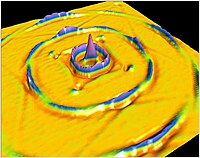
Photo from wikipedia
A numerical investigation is performed on the electroosmotic flow (EOF) in a surface-modulated microchannel to induce enhanced solute mixing. The channel wall is modulated by placing surface-mounted obstacles of trigonometric… Click to show full abstract
A numerical investigation is performed on the electroosmotic flow (EOF) in a surface-modulated microchannel to induce enhanced solute mixing. The channel wall is modulated by placing surface-mounted obstacles of trigonometric shape along which the surface potential is considered to be different from the surface potential of the homogeneous part of the wall. The characteristics of the electrokinetic flow are governed by the Laplace equation for the distribution of external electric potential; the Poisson equation for the distribution of induced electric potential; the Nernst–Planck equations for the distribution of ions; and the Navier–Stokes equations for fluid flow simultaneously. These nonlinear coupled set of governing equations are solved numerically by a control volume method over the staggered system. The influence of the geometric modulation of the surface, surface potential heterogeneity and the bulk ionic concentration on the EOF is analyzed. Vortical flow develops near a surface modulation, and it becomes stronger when the surface potential of the modulated region is in opposite sign to the surface potential of the homogeneous part of the channel walls. Vortical flow also depends on the Debye length when the Debye length is in the order of the channel height. Pressure drop along the channel length is higher for a ribbed wall channel compared to the grooved wall case. The pressure drop decreases with the increase in the amplitude for a grooved channel, but increases for a ribbed channel. The mixing index is quantified through the standard deviation of the solute distribution. Our results show that mixing index is higher for the ribbed channel compared to the grooved channel with heterogeneous surface potential. The increase in potential heterogeneity in the modulated region also increases the mixing index in both grooved and ribbed channels. However, the mixing performance, which is the ratio of the mixing index to pressure drop, reduces with the rise in the surface potential heterogeneity.
Journal Title: Theoretical and Computational Fluid Dynamics
Year Published: 2018
Link to full text (if available)
Share on Social Media: Sign Up to like & get
recommendations!